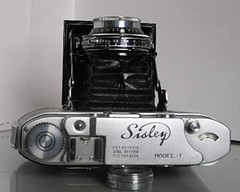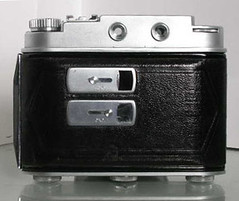Sisley 1 and Balm Six
The Sisley (シスレー, shisurē) Model-1, released around May 1954, was the first product of the newly renamed Takane Kōgaku, whose previous cameras had been the Daido Six and Daido Semi. It was advertised by Sumimitsu in May 1954[1] for ¥12,500, as the "Sisley 55".[2]
Contents
Description
The Sisley adds a non-coupled rangefinder to the Daido Six, a folder whose body was based on that for the Mihama Six. It has two windows for film numbers (for 6×6 or 6×4.5). Like all its successors, the Sisley comes with a 75mm f/3.5 lens; this one is named "Deep-C" and has front-cell focusing (calibrated in feet). The NKS-SC shutter is synchronized and provides for speeds of 1–200 and B; a plate on the front is marked for depth of field and with SISLEY.

|
| (Image rights) |
The camera is engraved at the top Sisley and (smaller) MODEL-1, and (smaller again) PAT NO 13010, SERIAL NO (and of course the serial number) and SIZE 6X6 4.5X6. On the left (as the camera is held by the photographer) is the film wind knob. Just to the right of this are an accessory shoe and a small button to open the front of the camera. At the far right are the shutter release button and a window for the readout of the rangefinder.
 
|
| (Image rights) |
There are two small eyepieces. That in the centre is for the viewfinder; translucent strips at the sides of the front of the finder show the distinction between the 4.5×6 and 6×6 views.[3] The eyepiece to the right is for the rangefinder. To the right of this is a thumbwheel for the rangefinder. The leather on the back does not seem to be marked with the name of the manufacturer.
On the centre of the outside of the lens door is a decorative silver oval plate, marked "Sisley". The struts are marked TKN (presumably for "Takane").
The name "Sisley"
"Sisley" had no particular meaning in Japan at the time other than the name of the Impressionist (English-born, French-domiciled) painter Alfred Sisley. His surname is conventionally rendered in Japanese as シスレー (Shisurē),[4] the same pronunciation as was used for this camera. French Impressionism was (and still is) hugely popular in Japan, and the name of the camera would certainly have evoked that of the painter.
The Balm Six
There was a name variant called Balm Six Model-1.[5] Its top plate is marked Balm six rather than Sisley, the plate on the lens door is marked Balm six 6 X 6, the leather on the back is unmarked. Its lens is marked BALM Anastigmat. The shutter is again an NKS-SC, but there is no depth-of-field scale (and no BALM marking to correspond to SISLEY). The film pressure plate is marked TAKANE K.K (as presumably is that of the Sisley).
Beyond the Model-1
Takane's next camera in the Japanese market would be the Mine Six. Perhaps it retained the Sisley name for some export markets: one version of the Mine Six was alternatively engraved "Sisley 2A"; and, according to McKeown, another version "Sisley 3A". For these models, see the Mine Six article.
Notes
- ↑ Within an advertisement (also showing the "Crystar 15") in Supuringu Kamera Zensho (スプリングカメラ全書), a special May 1954 issue of Photo Art (reproduced in Hagiya, p.152); and within an advertisement (also showing the Crystar models 15, 25, and 45) in the May 1954 issue of Asahi Camera (reproduced in Kokusan kamera no rekishi, p.135).
- ↑ Although advertised as "Sisley 55" and so called by Hagiya, it does not seem to be marked "55". The number seems instead to have been merely a marketing invention by Sumimitsu. (Number did not simply increase with price or prestige: the "Sisley 55" was intermediate in price between the "Crystar 25" and the "Crystar 45", front-cell- and unit-focusing TLRs respectively.)
- ↑ Or anyway show the distinction to people who are not wearing glasses and who look carefully. This is a squinty little finder.
- ↑ See for example the Japanese-language Wikipedia article on Alfred Sisley.
- ↑ Not mentioned by Hagiya or in Kokusan kamera no rekishi, but not rare.
Sources / further reading
- Asahi Camera (アサヒカメラ) editorial staff. Shōwa 10–40nen kōkoku ni miru kokusan kamera no rekishi (昭和10–40年広告にみる国産カメラの歴史, Japanese camera history as seen in advertisements, 1935–1965). Tokyo: Asahi Shinbunsha, 1994. ISBN 4-02-330312-7. Items 534 and 692.
- Hagiya Takeshi (萩谷剛). "Mine Shikkusu: Gunma-ken Takasaki-shi no kameramēkā" (ミネシックス:群馬県高崎市のカメラメーカー, Mine Six: A camera-maker in Takasaki, Gunma). Chapter 7 of Zunō kamera tanjō: Sengo kokusan kamera jū monogatari (ズノーカメラ誕生:戦後国産カメラ10物語, The birth of the Zunow camera: Ten stories of postwar Japanese camera makers). Tokyo: Asahi Sonorama, 1999. ISBN 4-257-12023-1. This history of Takane is based on Hagiya's interviews with four people who had been key figures in the company.
Links
In Japanese:
- Sisley repair notes and sample photos at Kan's Room (the top six photographs were taken with a Sisley; those below are from other cameras)
- Sisley and Balm Six in a page of the AJCC website: the photograph shows four folders with non-coupled rangefinders; clockwise from top left these are: Ofuna Six, Zenobia R, Sisley and Balm Six
